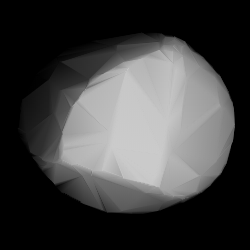 Massevitch modeled from its lightcurve | |
| Discovery [1] | |
|---|---|
| Discovered by | T. Smirnova |
| Discovery site | Crimean Astrophysical Obs. |
| Discovery date | 9 May 1972 |
| Designations | |
| (1904) Massevitch | |
Named after | Alla Massevitch (astronomer) [2] |
| 1972 JM ·1949 JH 1951 XN ·1958 JA 1962 CE ·1965 YH 1971 BF | |
| main-belt ·(middle) | |
| Orbital characteristics [1] | |
| Epoch 4 September 2017 (JD 2458000.5) | |
| Uncertainty parameter 0 | |
| Observation arc | 68.09 yr (24,870 days) |
| Aphelion | 2.9442 AU |
| Perihelion | 2.5477 AU |
| 2.7460 AU | |
| Eccentricity | 0.0722 |
| 4.55 yr (1,662 days) | |
| 218.92° | |
| 0° 12m 59.76s / day | |
| Inclination | 12.817° |
| 106.40° | |
| 261.22° | |
| Physical characteristics | |
| Dimensions | 13.503±0.211 km [3] 18.19 km (IRAS) [4] 18.25 km (derived) [5] |
| 5.394±0.003 h [6] | |
| 0.1613 (IRAS) [4] 0.1756 (derived) [5] 0.581±0.228 [3] | |
| SMASS = R [1] [5] | |
| 10.55 [3] ·11.2 [1] [5] ·11.21±0.49 [7] | |
1904 Massevitch (prov. designation: 1972 JM) is a background asteroid from the central region of the asteroid belt. It was discovered on 9 May 1972, by the Russian astronomer Tamara Smirnova at the Crimean Astrophysical Observatory in Nauchnyj, on the Crimean peninsula. [8] The uncommon R-type asteroid has a rotation period of 5.3 hours and measures approximately 16 kilometers (9.9 miles) in diameter. It was later named after Russian astrophysicist Alla Masevich. [2]